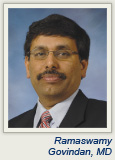 The results of the National Lung Screening Trial (NLST) will have important implications for practicing oncologists if low-dose helical CT screening is used routinely in the clinic.
The results of the National Lung Screening Trial (NLST) will have important implications for practicing oncologists if low-dose helical CT screening is used routinely in the clinic.
First, we will begin to find many more small tumors than we do now. This will pose new sets of questions for research: What should be the optimal strategy to manage these tumors? Should we be considering lesser resection for very small tumors instead of the conventional lobectomy? Will stereotactic radiotherapy be a preferable option to surgery for these tumors?
Second, are these small tumors detected through the CT screening process in asymptomatic individuals biologically different from the tumors we currently see when patients present with symptoms?
Fodder for Future Research
NLST is just the beginning. There are 1 billion smokers (current and former) in the world today. It is simply unrealistic to screen all smokers for lung cancer. The cost issues and logistics are not trivial. The important fact to keep in mind is that 1 in 10 smokers die of lung cancer. Is there a way to identify the population predisposed to developing lung cancer so that CT screening can focus on the really enriched population at risk? Recent advances in genomics give us hope that one day a simple and inexpensive molecular screening assay will identify the at-risk population for yearly CT screening. Like all good studies, NLST data not only advance the practice but also provide fodder for future research. ■
Disclosure: Dr. Govindan reported no potential conflicts of interest.
Dr. Govindan is Professor of Medicine, and Co-Director, Section of Medical Oncology, Washington University School of Medicine, St Louis.

